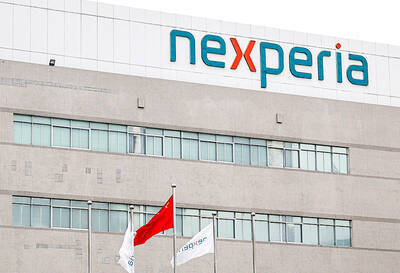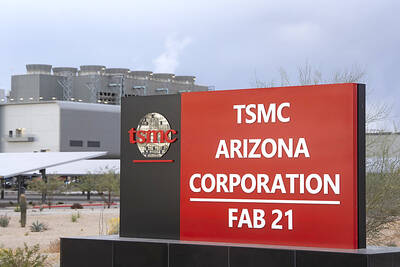Taiwan Semiconductor Manufacturing Co (TSMC, 台積電) listed the challenges of ensuring export control compliance by its customers, months after the company’s artificial intelligence (AI) silicon was found to have flowed to US-sanctioned Huawei Technologies Co (華為) via intermediaries.
“TSMC’s role in the semiconductor supply chain inherently limits its visibility and information available to it regarding the downstream use or user of final products that incorporate semiconductors manufactured by it,” the Hsinchu-based company said in its latest annual report released on Friday.
The world’s largest contract chipmaker said the constraint impedes its ability to prevent unintended end-uses of its semiconductors, as well as diverted shipments by business partners and third parties intent on circumventing sanctions.

Photo: Ann Wang, Reuters
In terms of whether there are going to be compliance issues found, the go-to chipmaker for Apple Inc and Nvidia Corp in the report said there is “no assurance,” despite TSMC’s best efforts to abide by relevant export control regulations.
TSMC provides manufacturing services to many so-called fabless firms and chip designers, including Nvidia. Very often, the semiconductors it customizes for those companies end up being incorporated in gadgets and devices made by third parties, most often for legitimate purposes.
For instance, Qualcomm Inc and MediaTek Inc (聯發科) work with TSMC to make mobile chips used by phone makers, including Xiaomi Corp (小米).
However, an investigation by Canada-based research firm TechInsights last year showed that Huawei’s Ascend 910B AI chip contained semiconductors by TSMC.
The chipmaker halted shipments to a client at about the same time after it found out the semiconductors it made for the customer ended up with Huawei.
TSMC alluded to the incident in the annual report and said it notified Washington and Taipei in October last year that a chip it made for a customer might have been diverted to a restricted entity.
The chipmaker added that it has been cooperating with authorities’ requests for additional information and documents.
US President Donald Trump’s administration has followed the footsteps of former US president Joe Biden in curbing the flow of advanced technologies to China out of national security concerns.
The US earlier this month unveiled a fresh round of regulations to tighten China’s access to advanced AI chips.
Earlier this year, Washington called for chip producers like TSMC and Samsung Electronics Co to step up their scrutiny and due diligence of customers, especially Chinese firms. US officials simultaneously blacklisted 16 Chinese companies including Sophgo Technologies Ltd (算能科技), which was allegedly involved in Huawei getting access to TSMC chips last year.
Together with Sophgo, the US also added PowerAir Pte Ltd to the entity list after the South China Morning Post reported concerns about the Singapore-based company’s possible involvement in diverting TSMC chips to Huawei.

JITTERS: Nexperia has a 20 percent market share for chips powering simpler features such as window controls, and changing supply chains could take years European carmakers are looking into ways to scratch components made with parts from China, spooked by deepening geopolitical spats playing out through chipmaker Nexperia BV and Beijing’s export controls on rare earths. To protect operations from trade ructions, several automakers are pushing major suppliers to find permanent alternatives to Chinese semiconductors, people familiar with the matter said. The industry is considering broader changes to its supply chain to adapt to shifting geopolitics, Europe’s main suppliers lobby CLEPA head Matthias Zink said. “We had some indications already — questions like: ‘How can you supply me without this dependency on China?’” Zink, who also

The number of Taiwanese working in the US rose to a record high of 137,000 last year, driven largely by Taiwan Semiconductor Manufacturing Co’s (TSMC, 台積電) rapid overseas expansion, according to government data released yesterday. A total of 666,000 Taiwanese nationals were employed abroad last year, an increase of 45,000 from 2023 and the highest level since the COVID-19 pandemic, data from the Directorate-General of Budget, Accounting and Statistics (DGBAS) showed. Overseas employment had steadily increased between 2009 and 2019, peaking at 739,000, before plunging to 319,000 in 2021 amid US-China trade tensions, global supply chain shifts, reshoring by Taiwanese companies and

Taiwan Semiconductor Manufacturing Co (TSMC, 台積電) received about NT$147 billion (US$4.71 billion) in subsidies from the US, Japanese, German and Chinese governments over the past two years for its global expansion. Financial data compiled by the world’s largest contract chipmaker showed the company secured NT$4.77 billion in subsidies from the governments in the third quarter, bringing the total for the first three quarters of the year to about NT$71.9 billion. Along with the NT$75.16 billion in financial aid TSMC received last year, the chipmaker obtained NT$147 billion in subsidies in almost two years, the data showed. The subsidies received by its subsidiaries —

At least US$50 million for the freedom of an Emirati sheikh: That is the king’s ransom paid two weeks ago to militants linked to al-Qaeda who are pushing to topple the Malian government and impose Islamic law. Alongside a crippling fuel blockade, the Group for the Support of Islam and Muslims (JNIM) has made kidnapping wealthy foreigners for a ransom a pillar of its strategy of “economic jihad.” Its goal: Oust the junta, which has struggled to contain Mali’s decade-long insurgency since taking power following back-to-back coups in 2020 and 2021, by scaring away investors and paralyzing the west African country’s economy.